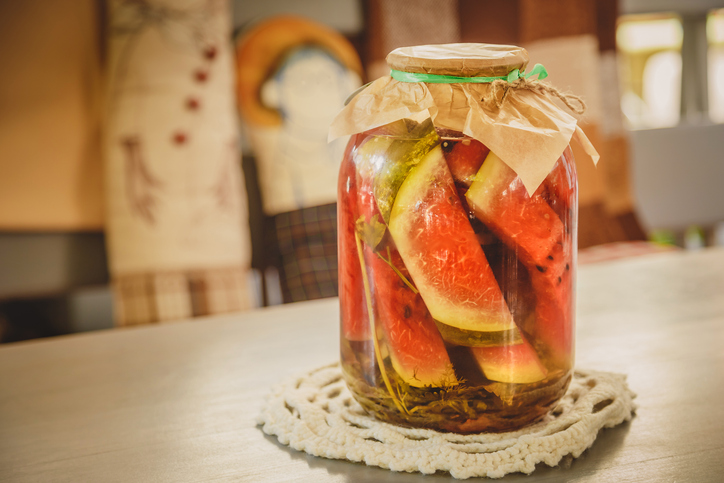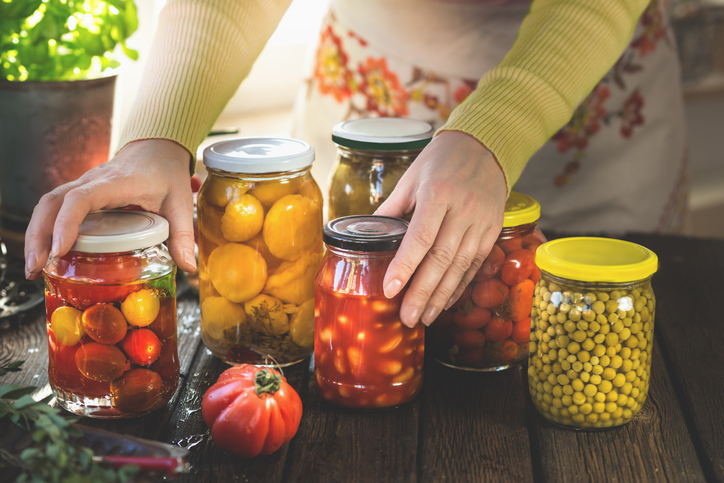Every summer has its “it” thing. One year it’s sourdough starters. Another, it’s backyard chickens. But this year? It’s pickles.
Quick pickles, to be exact. They're crunchy, colorful, and suddenly everywhere – from TikTok feeds to five-star menus. Whether you’ve got a garden full of overachieving cucumbers or just a taste for bold, briny flavor, pickling is having a real moment.
Pickling is back in a big way, and not just in old-school deli jars. From foodie feeds to competition kitchens, pickled everything is having a moment. At Intermountain Health, Enterprise Executive Chef Christopher Delissio is leading the charge, one watermelon rind at a time.
What is a quick pickle, anyway?
Quick pickling is the easygoing cousin of traditional canning. Instead of fermenting for weeks, you whip up a vinegar-based brine, pour it over sliced fruits or veggies, and let the fridge do the rest.
No boiling. No sealing. No pressure (cookware or otherwise).
Quick pickling is a method that takes little time and does not rely on the full fermentation process. Quick pickles can be prepared in minutes, and they allow your produce to last a few extra weeks by storing them in a vinegar and herb solution in the refrigerator.
That brine? It’s where the flavor magic happens. Vinegar, herbs, spices, salt, sugar – each ingredient adds a new twist.
Pickling starts with a vinegar solution that can be flavored with all kinds of herbs and spices to create unique flavor profiles. Different vinegars may be used such as rice wine vinegar, red wine vinegar, white balsamic, sherry, white wine vinegar, apple cider vinegar, etc. These flavors and the color twists pickling can make, along with the tang from the vinegar, make food exciting!
The dill-ightful benefits
Sure, pickles taste good, but they’re also good for you.
The vinegar and added herbs or spices increase health benefits by adding antioxidants along with the antimicrobial and blood sugar-controlling effects of the vinegar. When you make homemade pickles, you can control the salt and sugar which is usually the one drawback to store-bought pickles.
That means quick pickles are a way to spice up your plate, and they’re a smart kitchen hack for better health and less waste. You get to enjoy bold flavor and still stay in control of what goes in your food.
Rind and kind: Pickle the unexpected
Think pickles are just for cucumbers? Think again.
“I recently used some quick pickle recipes in a national competition held by Flavor and the Menu and Summit F&B group, leading to a win for myself and Intermountain Health,” says Chef Christopher. “The recipes I entered included pickled watermelon rind, saffron pickled turnips, and anise pickled blueberries.”
And the award-winning watermelon rind is shockingly simple to make.
Pickled watermelon rind recipe
Ingredients:
- 2 cups of white balsamic vinegar
- 2 cups of water
- 3 whole allspice berries, crushed
- 3 pink peppercorns, crushed
- 2 tbsp kosher salt
- 1 tbsp sugar
- 3 cups watermelon rind, diced small
Instructions:
- In a non-reactive pot, combine everything except the watermelon rind.* Bring to a gentle simmer, then remove from heat and let cool to room temperature.
- Pour the brine over the diced rind in a jar or container.
- Refrigerate and let sit overnight before serving.
“Pickled watermelon rind is a versatile and crunchy ingredient that may be added to a variety of dishes such as green salads, fruit salads, or it can be served with cheese and prosciutto instead of fresh melon. It is a unique topper to oysters or anything else that begs for a little extra refreshing tang!”
Toss it, top it, toast it: Ways to use your pickles
Once you’ve got your pickles, you can put them on just about everything. Chef Christopher offers up a few creative ways to serve them:
- Cold on their own
- Cold in salads and as additions to sides and sandwiches like the classic Vietnamese banh mi sandwich with pickled vegetables or muffaletta a New Orleans-style sandwich with pickled olives and vegetables.
- Hot. Sauté with olive oil or butter and use it as a side dish. Assorted pickled veggies glazed with veggie stock, shallots, parsley and a touch of butter is a great side dish to a grilled chicken breast or lean steak.
- The tang of pickled fruit is a great contrast in classic desserts like cheesecake or crème brûlée to cut through the richness of the dessert.
One of his favorite recipes? A summery bruschetta topped with pickled vegetables. Here’s how to make it:
Pickled vegetables and bruschetta recipe
Pickled veggie ingredients:
- 1 cup asparagus, sliced thin
- 3 cups cherry tomatoes, halved
- 1 large shallot, thinly sliced
- 3 cloves garlic, thinly sliced
- 2.5 tsp kosher salt
- 1 cup white balsamic vinegar
- 1 cup of water
- 6–8 fresh basil leaves
- 1–2 sprigs fresh thyme
- 4 tbsp extra virgin olive oil
- 1 bay leaf
Instructions:
- In a non-reactive pot, sauté half the olive oil with the shallots for 1 minute.* Add garlic and sauté for 1 minute more.
- Add vinegar, water, and salt. Bring to a simmer, then remove from heat and cool to room temperature.
- Pour over remaining ingredients (plus the other half of olive oil). Chill under 40°F in a sealed jar for several hours or overnight.
For the bruschetta:
- Toast small slices of crusty bread brushed with olive oil.
- Rub with a garlic clove.
- Top with fresh mozzarella and pickled vegetables.
- Serve immediately to keep everything crisp.
Pickles with a mission
At Intermountain Health, food is part of how we care for people – whether they’re patients, visitors, or team members.
We serve about 35,000 meals a day across our system, and every dish reflects our belief that food should be nourishing, comforting, and culturally thoughtful. From everyday meals to award-winning recipes, we’re always cooking up ways to help people live the healthiest lives possible.
Stay cool, stay crisp
So, whether your garden is going gangbusters or you’re just curious about trying something new, now’s the perfect time to join the pickle party.
Start with a jar. Grab some vinegar. Get briny. And who knows – you might just create something competition-worthy.
*A non-reactive pot is made from materials that won’t react with acidic ingredients like vinegar. Stainless steel, glass, or enamel-coated cookware are all safe bets. Avoid aluminum or uncoated cast iron. They can give your pickles a weird metallic flavor.


